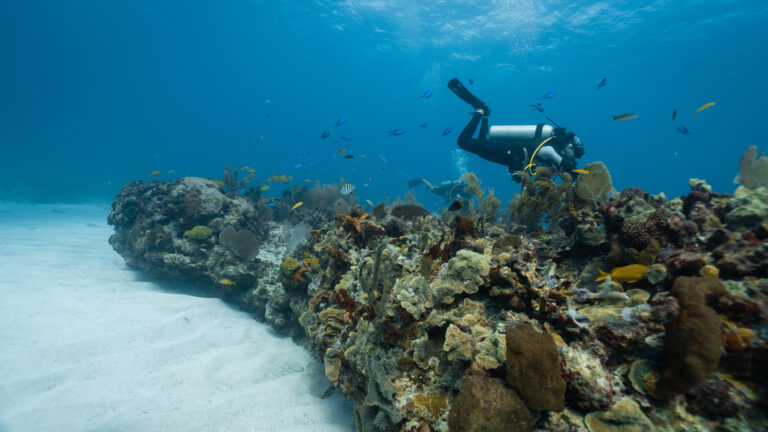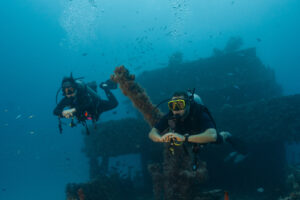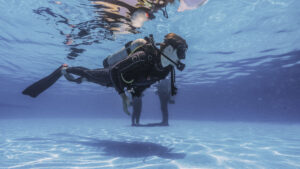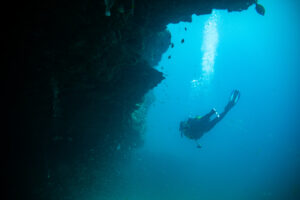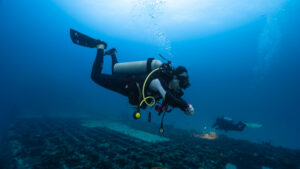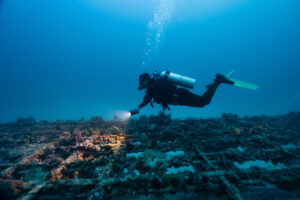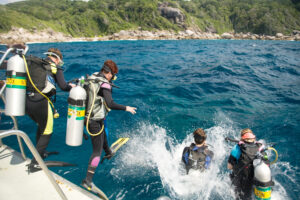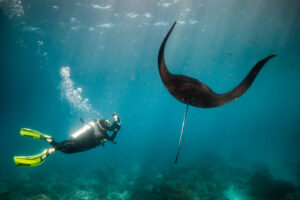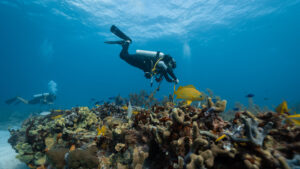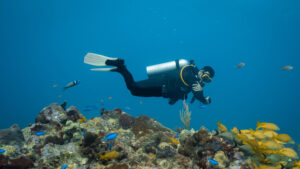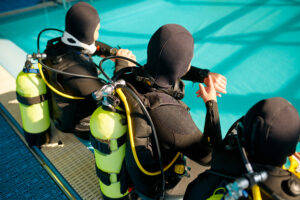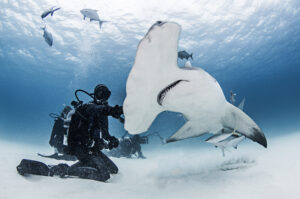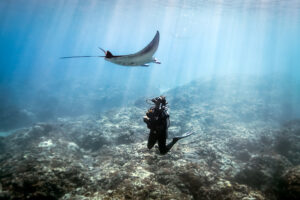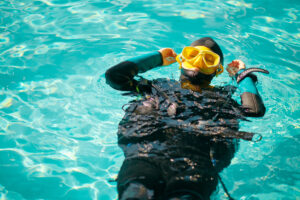What is Free Air?
Free air refers to air at atmospheric pressure, which is the pressure exerted by the weight of air in the Earth’s atmosphere. In the context of scuba diving, understanding the concept of free air is crucial for managing various aspects of dive planning and safety, including buoyancy, gas consumption, and decompression sickness. This entry will delve into the relationship between free air and compressed air, and how this understanding impacts diving practices.
Atmospheric Pressure
Atmospheric pressure, also known as air pressure or barometric pressure, is the force exerted by the weight of air molecules on a given area. At sea level, the average atmospheric pressure is approximately 14.7 pounds per square inch (psi) or 1 atmosphere (atm). This pressure is the result of the weight of the air above us in the Earth’s atmosphere.
As one ascends to higher altitudes, atmospheric pressure decreases because there is less air above to exert a force. For instance, at an altitude of 5,000 meters (16,404 feet), the atmospheric pressure is roughly half of that at sea level. This reduction in pressure with altitude can have significant effects on breathing and overall physiology, which is why it is essential to acclimatize when ascending to high altitudes.
In scuba diving, atmospheric pressure plays a pivotal role in understanding how gases behave under different conditions. When divers descend underwater, they experience an increase in pressure due to the weight of the water above them. For every 10 meters (32.8 feet) of seawater depth, the pressure increases by approximately 1 atmosphere. This increase in pressure affects the volume of air in the diver’s equipment and body, influencing buoyancy and gas consumption.
Free Air vs. Compressed Air
Scuba diving relies on the use of compressed air, which is air that has been pressurized and stored in a scuba tank. This allows divers to carry a sufficient supply of breathable gas for extended periods underwater. Compressed air is typically pressurized to around 200-300 bars (roughly 2,900-4,350 psi), depending on the capacity of the scuba tank. This high-pressure air enables divers to breathe comfortably at various depths.
In contrast, free air is the air we breathe at the surface, at atmospheric pressure. The difference between free air and compressed air is critical for understanding various aspects of scuba diving. For instance, the volume of air a diver breathes from their tank decreases with depth due to the increased pressure. This relationship between free air and compressed air is essential for managing buoyancy, gas consumption, and avoiding decompression sickness.
Understanding the transition from free air to compressed air and vice versa helps divers accurately plan their dives. When divers inhale from their tanks at depth, the air expands as they ascend, necessitating careful monitoring and adjustment to maintain proper buoyancy and avoid rapid ascents that can lead to decompression sickness. The knowledge of these principles ensures a safe and enjoyable diving experience.
Buoyancy
Buoyancy is the upward force exerted by a fluid (in this case, water) that opposes the weight of an object (the diver and their equipment) submerged in it. The buoyancy force is equal to the weight of the fluid displaced by the object. For scuba divers, managing buoyancy is a crucial skill that allows them to control their position in the water column.
A scuba diver’s buoyancy is affected by the volume and weight of the air in their lungs, as well as the air in their buoyancy control device (BCD). As a diver descends, the surrounding water pressure increases, causing the volume of the air in their lungs and BCD to decrease, following Boyle’s law. This decrease in volume results in a reduction in buoyancy, requiring the diver to add air from their compressed air supply to maintain neutral buoyancy.
The relationship between free air and compressed air is fundamental to understanding buoyancy changes. At the surface, air in the BCD and lungs is at atmospheric pressure. However, as the diver descends and the pressure increases, the air compresses, reducing its volume and buoyancy. Divers must constantly adjust the air in their BCD to compensate for these changes, ensuring they neither sink uncontrollably nor ascend too quickly.
Effective buoyancy control involves balancing the air in the BCD and the diver’s lungs. Divers learn to use their breath to fine-tune their buoyancy, taking shallow breaths to ascend slightly and deeper breaths to descend. Mastery of buoyancy control enhances safety and allows divers to conserve energy, making their underwater experience more efficient and enjoyable.
Gas Consumption
A diver’s rate of gas consumption is influenced by several factors, including depth, exertion, and individual breathing patterns. The deeper a diver goes, the higher the ambient pressure, which affects how the body uses air. Understanding the relationship between free air and compressed air is vital for managing gas consumption during a dive.
At depth, the increased ambient pressure causes the volume of compressed air to decrease as it is inhaled from the scuba tank. However, the air in the diver’s lungs remains at the same pressure as the surrounding water. This means that, at greater depths, divers consume more air per breath because the inhaled air is more compressed than at the surface. For example, at a depth of 20 meters (65.6 feet), a diver breathes in air at three times the atmospheric pressure, consuming air three times faster than at the surface.
Several strategies help divers manage their gas consumption efficiently. Proper breathing techniques, such as slow, deep, and controlled breaths, can significantly reduce air usage. Additionally, maintaining a relaxed and streamlined posture minimizes exertion, further conserving air. Divers should also monitor their air supply regularly and plan their dive profiles to ensure they have sufficient air for the entire dive, including a safety reserve.
Understanding gas consumption rates is crucial for dive planning. Divers calculate their surface air consumption rate (SAC), which is the amount of air used per minute at the surface, and adjust it for the planned depth to estimate their air requirements. By factoring in the differences between free air and compressed air, divers can plan their dives to maximize safety and enjoyment.
Decompression Sickness
Decompression sickness (DCS), also known as “the bends,” is a potentially dangerous condition caused by the formation of gas bubbles in a diver’s tissues as they ascend to the surface. Nitrogen, which makes up 78% of the air we breathe, is absorbed into the body’s tissues while diving. As a diver ascends and the surrounding pressure decreases, the absorbed nitrogen comes out of solution and forms gas bubbles, which can cause pain, tissue damage, and even death.
Understanding the relationship between free air and compressed air is crucial in avoiding decompression sickness. Divers must ascend slowly, allowing the dissolved nitrogen to be released from the tissues gradually. Rapid ascents can cause nitrogen to form bubbles in the blood and tissues, leading to DCS. To mitigate this risk, divers follow specific ascent rates and perform safety stops and decompression stops as necessary.
Safety stops are typically conducted at a depth of 5 meters (16.4 feet) for three to five minutes near the end of a dive. These stops provide additional time for nitrogen to be released from the body safely. For dives that exceed no-decompression limits, divers must perform decompression stops at various depths to avoid DCS. Dive computers and dive tables help divers plan these stops based on their dive profile and the amount of nitrogen absorbed during the dive.
Symptoms of decompression sickness can vary widely, from joint pain and dizziness to more severe cases involving paralysis or unconsciousness. Immediate treatment involves administering 100% oxygen and seeking medical attention, often in a hyperbaric chamber, where the diver can be recompressed and then slowly decompressed under controlled conditions. Awareness and understanding of decompression principles are vital for preventing DCS and ensuring diver safety.
Dive Planning and Safety
A thorough understanding of free air and compressed air is essential for proper dive planning and safety. Divers must consider factors such as gas consumption, decompression limits, and surface intervals to ensure a safe and enjoyable diving experience. Effective dive planning begins with a clear understanding of the dive objectives, the environmental conditions, and the individual diver’s experience and fitness level.
Gas management is a critical component of dive planning. Divers calculate the required air supply for the planned dive, considering their breathing rate, depth, bottom time, and the need for a reserve supply in case of emergencies. This involves understanding the differences between free air and compressed air to determine the appropriate volume of air required for a dive. Divers use their surface air consumption rate (SAC) as a baseline and adjust for the planned depth to estimate their air requirements accurately.
Dive tables and dive computers are essential tools for planning dives and managing decompression. These tools take into account the differences between free air and compressed air to calculate safe ascent rates, decompression stops, and no-decompression limits. Dive tables, developed by the U.S. Navy and other organizations, provide guidelines for divers based on depth, time, and repetitive dive profiles. Dive computers, on the other hand, offer real-time information and calculations during the dive, allowing for greater flexibility and more accurate decompression management.
Proper breathing techniques are essential for conserving air and managing buoyancy during a dive. Divers should practice slow, deep, and controlled breathing to maximize the efficiency of air consumption. Additionally, awareness of the differences between free air and compressed air can help divers adapt their breathing patterns to the changing pressures and gas densities at depth. Effective breathing techniques contribute to a relaxed and enjoyable diving experience.
Surface intervals are the time spent at the surface between dives, allowing the body to off-gas excess nitrogen absorbed during the dive. A sufficient surface interval is critical in reducing the risk of decompression sickness on subsequent dives. Dive tables and computers take into account the differences between free air and compressed air to calculate appropriate surface intervals based on the dive profile. By planning adequate surface intervals, divers can minimize the risk of DCS and enjoy safer diving experiences.
Key Takeaways
Understanding the concept of free air, or air at atmospheric pressure, is vital for scuba divers. This knowledge helps divers manage buoyancy, gas consumption, and decompression risks effectively. By considering the differences between free air and compressed air, divers can plan and execute safe dives, ensuring they have an enjoyable and secure underwater experience.

